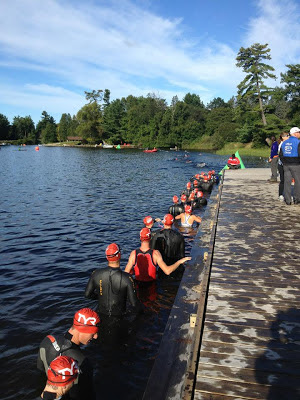All too often, you only hear about an athlete’s successes: the epic workouts, personal bests and podium finishes. Burnout, injury, scratched races and DNFs just don’t get the same billing. The reality is that training and racing at a high level can be a roller-coaster ride. Sometimes it can be hard to tell if you’re building to a peak or edging towards a meltdown. Finding the balance between training and recovery that optimizes performance and long-term development can be a tightrope walk. I have been open about my struggles in the past and I appreciate when others do the same. After my race report, you can read on for some lessons I learned following my first long course triathlon.
Back to Bracebridge…
One of the unique features of this race is the time trial format with athletes released one at a time in a rolling start. I have a love-hate relationship with this format. On one hand, tactics are largely irrelevant, making the race a more pure test of individual ability. On the other hand, it guarantees maximum suffering for the entirety of the race since you never know exactly where you stand relative to your competitors (mental arithmetic being exponentially more difficult in an oxygen deprived state). An extra finishing kick could make all the difference but you won’t know until the dust has settled!
Swim (1500 m): 19:10, 3rd
I had bib #1, meaning that I was supposed to start first. But as I learned, even elites can make rookie mistakes; I mistimed my warm-up and just missed my start! Thankfully, Race Director Jason Vurma calmly assured me that he could slot me in 6th position. I could have hugged him. After recovering my composure, the swim was smooth and uneventful. I moved up into second place coming into transition.
Pseudo-pro tip: I’m usually a fan of clear goggles, but tinted or mirrored lenses are essential for this race. Every year, I have been blinded by the morning sun rising over the river on the return section of the swim.
 |
| These racers lined up in time for their start… |
Bike (40.8 km): 1:00:31, 2nd
I quickly moved into the lead feeling strong and confident…
…right up until Andrew Bolton, who started 45 seconds behind me, passed me like I was standing still on the course’s steepest climb around the 5 km mark. I had hoped to hold him off longer than that! That’s when I realized that a comfortable victory was not in the cards.
Despite my advocacy for racing au naturel (i.e. technology-free), my new power meter proved to be quite useful for pacing, particularly to reign in effort on the climbs. For the data-junkies, here’s my ride on Strava (minus the bike mount/dismount) and here are some details:
Average power: 292 W (~4.5 W/kg)
Normalized power: 298 W
Average cadence: 103 rpm (!)
Elevation: 362 m / 1200 ft
Pseudo-pro tip: I recently switched to a compact crankset (i.e. 50/34 vs. standard 53/39) on my tri bike. Before you pooh-pooh compact gearing as a wimpy option for weak cyclists, consider that I averaged over 40 km/h and only spun out on one descent (reaching nearly 80 km/h). Also consider this surprising fact: 50×11 is faster than 53×12. The compact allowed me to maintain a high cadence on the course’s many climbs and save my legs for a quick run. Here’s my article making the case that the vast majority of triathletes—even fast ones—should be riding compacts: 10 Reasons to Consider Compact Cranks.
Bike nutrition: ~400 mL (~150 Cal) maltodextrin-based homemade sports drink
Run (10 km): 34:03, 1st
Despite redlining the ride, I was 2:10 down on Andrew coming out of transition (including the 45 second start time gap). It was an exact replay of last year and not an unfamiliar position for me. I ran well and managed to catch Andrew before the 6 km mark, but the work wasn’t over since I needed a 45 second lead to win.
At the finish line, MSC Founder and President John Salt counted down 45 seconds. I was pretty sure that I was in the clear, but the seconds still ticked by unbearably slowly as I waited. It was fun to see similar drama among racers of all levels as they waited for the official results.
Run nutrition: I swished a mouthful of sports drink around for ~10 seconds a couple times. Many studies have found performance benefits with this “carbohydrate mouth rinse” (e.g. 1, 2, 3, 4). The cool thing is that this effect is entirely brain-driven, occurring before the sugar is even swallowed or absorbed!
Pseudo-pro tip: Glue the insoles of your racing flats in place to prevent them from bunching up when you cram on your shoes in transition.
Thank you to…
- MultiSport Canada for another top-notch event and for supporting the Recharge with Milk Development Team.
- Richard Pady of Healthy Results Training for helping me get me back on track, again…
- Nineteen Wetsuits for helping me achieve a personal best swim.
- the race volunteers for making these events possible.








